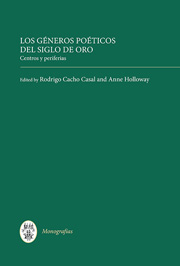Book contents
- Frontmatter
- Dedication
- Contents
- Índice de ilustrationes
- Índice de colaboradores
- Introducción: Géneros, centros, periferias
- I DEL CENTRO A LA PERIFERIA: GÉNEROS Y CONTRAGÉNEROS
- II AGUDEZA, RETÓRICA Y EMBLEMÁTICA
- III GÓNGORA Y SU ESTELA
- IV POESÍA COLONIAL: EL NUEVO CENTRO
- V LA POESÍA Y SUS MARCOS: MANUSCRITOS, ANTOLOGÍAS, MISCELÁNEAS
- Bibliografía
- Índice onomástico
Introducción: Géneros, centros, periferias
Published online by Cambridge University Press: 05 September 2013
- Frontmatter
- Dedication
- Contents
- Índice de ilustrationes
- Índice de colaboradores
- Introducción: Géneros, centros, periferias
- I DEL CENTRO A LA PERIFERIA: GÉNEROS Y CONTRAGÉNEROS
- II AGUDEZA, RETÓRICA Y EMBLEMÁTICA
- III GÓNGORA Y SU ESTELA
- IV POESÍA COLONIAL: EL NUEVO CENTRO
- V LA POESÍA Y SUS MARCOS: MANUSCRITOS, ANTOLOGÍAS, MISCELÁNEAS
- Bibliografía
- Índice onomástico
Summary
En 1614 salió de la imprenta de la viuda de Alonso Martín el libro poètico más ambicioso de Miguel de Cervantes: el Viaje del Parnaso. Este texto retoma la tradición italiana de los viaggi di Parnaso, y describe el ascenso del poeta a la cumbre del monte de las musas como una ardua travesía debido a las ‘muchas leguas de la gran jornada’. Los varios capítulos de la obra describen lo que Pierre Bourdieu llamaría el campo literario, un espacio simbólico en el que el autor de versos procura hacerse lugar en un territorio ocupado por rivales contemporáneos y modelos del pasado, subiendo desde la periferia de la poesía hasta su centro más alto. Este camino está hecho de conexiones que dependen de la influencia social y política del escritor, su ámbito geográfico, así como su éxito comercial, pero sobre todo de un aprendizaje personal que en el Siglo de Oro no tiene que ver tan solo con las reglas del juego delineadas por el crítico francés. El poeta es ante todo un alumno, heredero de una tradición que siente fuertemente y que se organiza intelectual y simbólicamente como un cursus litterarum.
- Type
- Chapter
- Information
- Los géneros poéticos del Siglo de OroCentros y periferias, pp. 1 - 10Publisher: Boydell & BrewerPrint publication year: 2013



